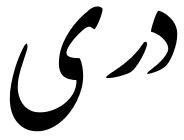Language/Dari/Vocabulary/Clothes
Hi Dari learners! 😊
In this lesson, we will focus on clothing vocabulary in Dari, and also learn about some interesting facts related to Afghan traditional clothes. Let's get started!
Consider broadening your understanding by checking out these related lessons: Food, Resources, Basic Greetings & Weather Vocabulary.
Traditional Clothing in Afghanistan[edit | edit source]
Clothing in Afghanistan is part of the rich cultural heritage, with its designs and fabrics originating from many different tribes and regions of the country. Over the centuries, traditional Afghan clothes have both adapted to changing styles and influences from neighbouring countries, while at the same time retained their unique traditional features.
The clothing worn by Afghan people is often bright, colourful and adorned with intricate embroidery, making them a feast for the eyes. For instance, the "kuchi" people from eastern Afghanistan are renowned for their traditional colourful dresses and magnificent jewellery, which are a symbol of their nomadic life.
Let's learn some Dari vocabulary for clothing pieces that are commonly worn in Afghanistan:
Vocabulary[edit | edit source]
| Dari | Pronunciation | English |
|---|---|---|
| بلوچی | baloochi | Coat |
| چادر | chaador | Veil |
| کمربند | kamarband | Belt |
| کمرکش | kamar-kosh | Trousers |
| کفش | kafsh | Shoes |
| کلاه | kalaah | Hat |
| دامن | daaman | Skirt |
| جلیقه | jelikeh | Jacket |
| شال | shaal | Scarf |
| شلوار | shalwaar | Pants |
| کتونی | katoonii | Cotton shirt |
| وشمگیر | washmgir | Shawl |
Now let's see some examples to see how these words can be used in context:
- Person 1: چاپان نقرهای مجلس کبیر مناسب است که فقط مانتو پوشیده باشید. (Chapan-e naghrahay-e Majlis-e Kabir-e monaasib ast ke faghat manto pushide bashid.) (A dark coat is suitable for attending the big event, just wear a coat.)
- Person 2: چراغ های پذیرایی برای شلوار و پیراهن شگفت انگیز است. (Charaagh-haa-ye paziraaii baraa-ye shalvaar o piraahein shogheft-angiz ast.) (The reception lights are amazing with pants and shirt.)
Additional Vocabulary[edit | edit source]
Now, let's add to our vocabulary just a bit and learn some adjectives that are useful when describing clothes.
| Dari | Pronunciation | English |
|---|---|---|
| نازک | naazuk | Thin |
| ضخیم | zakhim | Thick |
| کوتاه | ku-taah | Short |
| بلند | baland | Long |
| رنگارنگ | rang-aarang | Colorful |
| شیک | shiik | Stylish |
| کلاسیک | klassik | Classic |
| رسمی | rasmi | Formal |
| غیررسمی | gheyr-e rasmi | Casual |
| جوان پسند | jawaan-pasand | Youthful |
| ساده | saadeh | Simple |
Now, let's see some examples of these adjectives in use:
- Person 1: این پیراهن خیلی رسمی است. (In piiraahan kheili rasmi ast.) (This shirt is very formal.)
- Person 2: فکر کنم رنگ روشن این تونیک برای یه جلسه غیر رسمی خوب باشه. (Fekr konam rang-e roshan-e in tuniik baraa-ye ye jolose-ye gheyr-e rasmi khoob baashe.) (I think the bright colour of this tunic would be great for a casual meeting.)
Interesting Facts[edit | edit source]
- The traditional clothes of Afghanistan have fascinated people worldwide, leading to their adoption by fashion designers internationally. For instance, the embroidery of the Kuchi people has been used in collections made by Gucci, Chloe and Oscar de la Renta.
- Men and women's traditional Afghan clothes size are not marked in numbers. Instead, clothing items are usually made in free size, tailored to fit all body types, since it was capital punishment to charge more for a fatter person.
- The "pashmina" shawl is famous worldwide and originated from Afghanistan. It is a type of cashmere wool that is ethically and locally sourced from Changthangi goats in the high-altitude regions of Kashmir and parts of Afghanistan. The shawls are known for their warmth, softness and feather-light weight, making them a luxurious item.
To improve your Dari Vocabulary, you can also use the Polyglot Club website. Find native speakers and ask them any questions!
Other Lessons[edit | edit source]
- Feelings and Emotions
- Resources
- Health
- Geography
- Food
- How to Say Hello and Greetings
- Count to 10
- Fruits
- Education
- Days of the Week
Sources[edit | edit source]

